(Adding categories) |
(Adding categories) |
||
| Line 99: | Line 99: | ||
[[Category:Turok Creatures]] |
[[Category:Turok Creatures]] |
||
[[Category:Dinotopia Creatures]] |
[[Category:Dinotopia Creatures]] |
||
| + | [[Category:Dinosaurs of Asia]] |
||
Revision as of 08:58, 23 January 2021
| Kentrosaurus | |
|---|---|
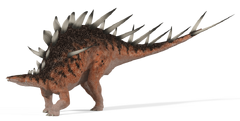
| |
| A restoration of Kentrosaurus aethiopicus | |
| Scientific classification | |
| Kingdom: | Animalia |
| Phylum: | Chordata |
| clade: | Dinosauria |
| Order: | †Ornithischia |
| Suborder: | †Stegosauria |
| Family: | †Stegosauridae |
| Genus: | †Kentrosaurus Hennig, 1915 |
| Binomial name | |
| Kentrosaurus aethiopicus Hennig, 1915 | |
| Synonyms | |
| |
Kentrosaurus (ken·tro·saur·us) is a genus of stegosaurid dinosaur from the Late Jurassic of Tanzania. Its fossils have been found only in the Tendaguru Formation of Tanzania, dated to the Kimmeridgian stage, between about 155.7 ± 4 Ma and 150.8 ± 4 Ma (million years ago). Apparently, all finds belong to one species, K. aethiopicus Hennig 1915. Kentrosaurus generally measured around 4.5 metres (15 ft) in length as an adult, probably had a double row of small plates and spikes running down its back, and could use its tail as a "thagomizer" for defense.
The extra-long shoulder spikes protected it from side attacks.
Description
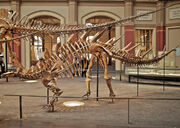
Kentrosaurus skeleton
Kentrosaurus aethiopicus was a small stegosaur, smaller than Stegosaurus armatus, Hesperosaurus mjosi, Dacentrurus armatus and Tuojiangosaurus multispinus, and about as large as Huayangosaurus taibaii. The total length of a composite skeletal mount in the Museum für Naturkunde Berlin, Germany, from the tip of the snout to the tip of the tail is 4.5 m (15 ft). Slightly more than half of this length is made up by the tail. Larger single elements were found, so that the animal could probably attain a total length of 5.5 m (18 ft). The long tail of Kentrosaurus results in a position of the center of mass that is unusually far back for a quadrupedal animal. It rests just in front of the hip, a position usually seen in bipedal dinosaurs. However, the femora are straight in Kentrosaurus, as opposed to typical bipeds, indicating a straight and vertical limb position. Thus, the hind feet did not support the animal alone, and the fore feet took up 10 to 15% of the bodyweight. The posterior position of the center of mass may not have been advantageous for rapid locomotion, but meant that the animal could quickly rotate around the hips by pushing sideways with the arms, keeping the tail pointing at threats.
Kentrosaurus can be distinguished from other members of the Stegosauria by a number of osteological characters. Most notably, the neural spines in the tail are not sub-parallel, as in most dinosaurs. In the anterior third of the tail, they point backwards, the usual direction. In the middle tail, however, they are almost vertical, and further back they are hook-shaped and point forward. Also typical are, among other features, that the dorsal vertebrae have a neural arch more than twice as high as the centrum, and completely occupied by the extremely spacious neural canal. The preacetabular process of the ilium widens laterally, and does not taper.
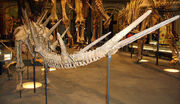
The spikes on the Kentrosaurus tail
The elements of the dermal armour of Kentrosaurus were, aside from a few exceptions, not found in close association with other skeletal remains. Thus, the exact position of most osteoderms is uncertain. A pair of closely spaced spikes was found articulated with a tail tip, and a number of spikes were found apparently regularly spaced in pairs along the path of an articulated tail. Hennig and Janensch, while grouping the dermal armour elements into four distinct types, recognized an apparently continuous change of shape among them, suggesting an uninterrupted distribution along the entire body. Because all elements were found in two symmetrical forms, the dermal armour appears to have been placed in at least two parallel rows, although an altenating placement is theoretically possible.
History
The first fossils of Kentrosaurus were discovered by the German Tendaguru Expedition in 1909, recognized as belonging to a stegosaur by expedition leader Werner Janensch on 24 July 1910, and described by German palaeontologist Edwin Hennig in 1915. During four field seasons, the German Expedition found over 1200 bones of Kentrosaurus, many of which were destroyed during the Second World War. Today, almost all remaining material is housed in the Museum für Naturkunde Berlin (roughly 350 remaining specimens), while the museum of the Institute for Geosciences of the Eberhard-Karls-University Tübingen houses a composite mount, roughly 50% of it being original bones. Although no complete individuals were found, some material was found in association, including a nearly complete tail, hip, several dorsal vertebrae and some limb elements of one individual. These form the core of a mount in the Museum für Naturkunde by Janensch. The mount was dismantled during the museum renovation in 2006/2007, and re-mounted in an improved pose by Research Casting International. Some other material, including a braincase and spine, was thought to have been misplaced or destroyed during World War II. However, all the supposedly lost cranial material was later found in a drawer of a basement cupboard. The British Tendaguru Expedition also found material, but it is unclear how much, in what state of preservation, and where it is today. The type and sole species of Kentrosaurus is K. aethiopicus. Fragmentary fossil material from Wyoming, named Stegosaurus longispinus by Charles Gilmore in 1914, has been suggested to belong to a North American species of Kentrosaurus. However, this notion has not found any support in the professional community.
Paleobiology
Like all ornithischians, Kentrosaurus was a herbivore. Only a single complete tooth was known when Hennig published his monography in 1925. Later, a part of a dentary was found, which bears a just emerging tooth, and some tooth fragments were recovered from matrix sticking to other bones. The dentary is almost identical in shape to that of Stegosaurus, albeit much smaller. Similarly, the tooth is a typical stegosaurian tooth, with a widened base and vertical grooves creating five ridges. It indicates a herbivorous diet. The fodder was barely chewed and swallowed in large chunks.
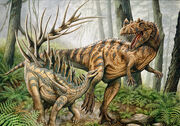
A Kentrosaurus fighting a Ceratosaurus with its tail
One theory on stegosaurid diet holds that they were low-level browsers, eating foliage and low-growing fruit from various non-flowering plants. It may also have been possible for Kentrosaurus to rear up on its hind legs to reach vegetation higher in trees. Because the tail had at least 40 caudal vertebrae, it was highly mobile. Probably, it could flex as much as the tails of modern crocodiles, which are almost able to touch the tips of their tails to the body side. This made the tail a dangerous weapon, able to cover a large arc when swinging quickly. Swing speeds may have been as high as 50 km/h, causing lethal strikes against for example theropod skulls, and significant harm when other body parts were hit.
In the media
- It appears in Jurassic Park: Operation Genesis as a 2-stars dinosaur which can be found on the Tengaduru Beds.
- It also appears in Dinosaur King, with the Earth attribute.
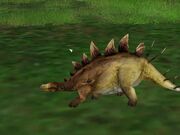
Jurassic Park Operation Genesis Kentrosaurus
- Kentrosaurus appears in the movie Ice Age: Dawn of the Dinosaurs and the video game adaption.
- Kentrosaurus appears in Jurassic World: The Game. It is a legendary tournament herbivore.
- Kentrosaurus will be appearing in Jurassic World: Evolution.
- Kentrosaurus will be appearing in Jurassic World: Alive.
- Kentrosaurus appears in ARK: Survival Evolved.
- Kentrosaurus appears in the game Parkasaurus.
- Kentrosaurus appears in Dino Dana.
Gallery
Kentrosaurus/Gallery